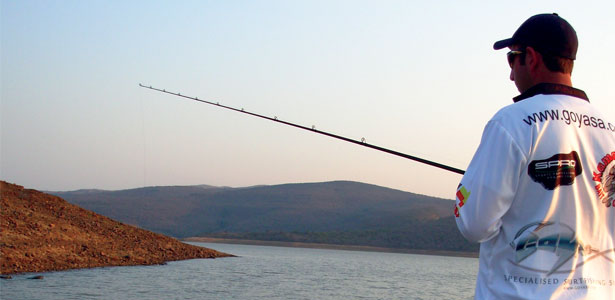
With personal bests broken and the ‘heavenly’ spawn period coming to a sad end, the inevitable challenge of catching the elusive post-spawn bass now presents itself. When faced with post- spawn bass I look at the following criteria for my time on the water.
1.Bass Movement
The general rule of thumb is that males stay shallow while the females move deeper. Reasons for this are that males stay behind to guard and protect the young bass fry while females move deeper (first or second major depth change/breakline) to recover from the spawn.
Cock fish (males) position their young fry to any forms of cover in the shallows, which helps limits the threats to the young bass. Often anglers will see fry moving on the water surface or see swirls as other bass feed on the easy prey, thus giving away their location. A quick cast in that general direction will mostly result in greater chances of a strike!
With the spawn finished, females that have moved out to the deeper haunts do eat, but choose not to chase down prey with their usual aggression and intent. Once female bass have regained their strength they will feed as usual, in both deep and shallow water – remembering that big females move back to the shallows to feed heavily during the arriving bream (kurper) spawn.
2. Structure
Bass spawn on ANY hard bottom/structure - rock, gravel, ant heaps, tree stumps, tyres, tree forks etc. Because of this, when first approaching a ‘spot’ to fish anglers should always fan cast to any of this visible structure as some late spawning fish might still be bedding, or males might be around guarding fry.
The presence of grass in any dam is a bonus as this gives the male bass and it's young a place to hide and feed. A rock/grass combination is always a good starting point for me. Throwing weightless 4”, 5” and 7” baits into these holes in the grass should lead to some aggressive takes.
Remember to watch your line for bites when fishing weightless baits – this will result in more fish being hooked and fewer fish being hooked very deep in the throat.
Females tend to seek out the less obvious structure and relate more to sunken trees, submerged rock piles and subtle breaks in water depth. Look for any of these forms of structure leading out from their recent spawning grounds to major points in the dam. Good knowledge of the dam or good electronics will enable anglers to find the less obvious structure easier.
3. Lure Selection
Post spawn is known as ‘junk’ fishing time - what I mean by this is that I'll start fishing the day with anything from 6 to 8 rods on the deck, all tied with different lures allowing me to cover the full water column and not waste time changing lures. The longer the day goes and the more fish that come aboard, the fewer rods one tends to use. By the end of the day I'll only be throwing 1or2 rods because I should be a lot more confident at putting a pattern together.
Early morning will always be started with a top water lure, even if it is only for the first 30 minutes of the day. Surface lures do produce larger than average fish and in the early morning larger bass are feeding a little more actively.
Structure dependant, my favourite bait to fish in weeds/thick vegetation/grass is a Bronzeye popping frog (colour of frog is dependant on water colour, mood of the fish, time of day and clear or overcast skies). For rocks and trees the Zara Spook is hard to beat. For suspending post spawn fish, cast into the holes in the weed lines, gaps in the trees and across points that drop off fairly quickly. Let the bait sit motionless on the surface for a couple of seconds before starting your retrieve. This has resulted in some explosive strikes for me in the past and will do the same for you.
My next and probably most consistent search baits are crankbaits and swimbaits. Both baits allow me to cover vast amount of water and depth ranges in a single cast and at times allow me to find those ‘hidden gems’ spots that are not usually visible to the eye. The Little John crankbait series ranging from shallow to deep divers has accounted for many good fish over the past season. This small profiled 1/2oz bait allows me to cast extreme distances and stay in that strike zone much longer - giving me the better chances of finding those roaming females. Swimbaits come in two forms, either hard or soft plastic. A 4” Bluegill BBZ1 Shad swimbait is my go to bait with hard swimbaits. This bait better suits the smaller baitfish profiles found in most of the SA waters. Soft body swimbaits have various hook options available for anglers to choose from, depending on the structure they intend fishing. The Treats range of soft swimbaits have become my preferred bait of choice. When these baits are rigged using the ‘line through’ system it allows the bait to look very natural in swimming action and colour.
Postspawners are hungry yet they not inclined to chase down baitfish/prey. Saying that, when a well presented, natural looking crankbait or swimbait deflects or swims past a bass – natural instinct takes over and they are forced to strike. This is the ‘reaction’ bite, one so often hears in bass fishing.
Once I've found and located my depth and structure I want to be fishing I will always come back to the area to fish it more thoroughly with weightless, mojo or Carolina rigs (wind dependant). Preferred plastic baits for weightless and mojo rig Deep Stix and 5” Twitch Shads. With carolina rigging my choice of baits would be large 10 inch worms, 8” lizards or 7” Fluke Style baits.
4. Weather
Post spawn is when we in SA usually experience some fairly erratic weather situations. The rain season is approaching in most parts of the country and as our waters fill, the bass disperse into the vast amounts of newly flooded cover. Now, there is an abundance of cover for the bass to roam and baitfish/prey is usually plentiful. I try to fish more isolated structure and fish it with multiple cast from different angles rather than fish the new submerged forest! The local bream species should be up shallow, spawning or nearing their spawn. Postspawn bass now move in to feed on these bait so anglers should always try locate the bream breeding areas in their local dams.
The post spawn is considered a tough time to consistently catch good fish. So be prepared for a tough day on the water. Cover lots of water, use some of the tips discussed and hopefully you will gain more knowledge of bass movement and feeding habits during the postspawn!!


 Visit us our
Visit us our